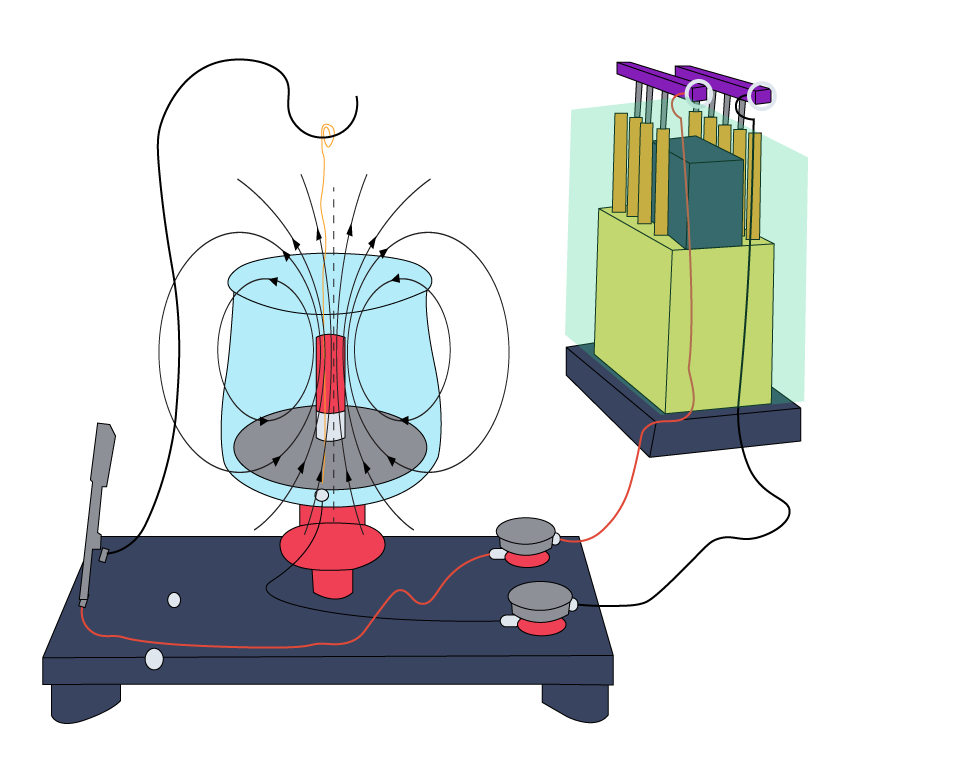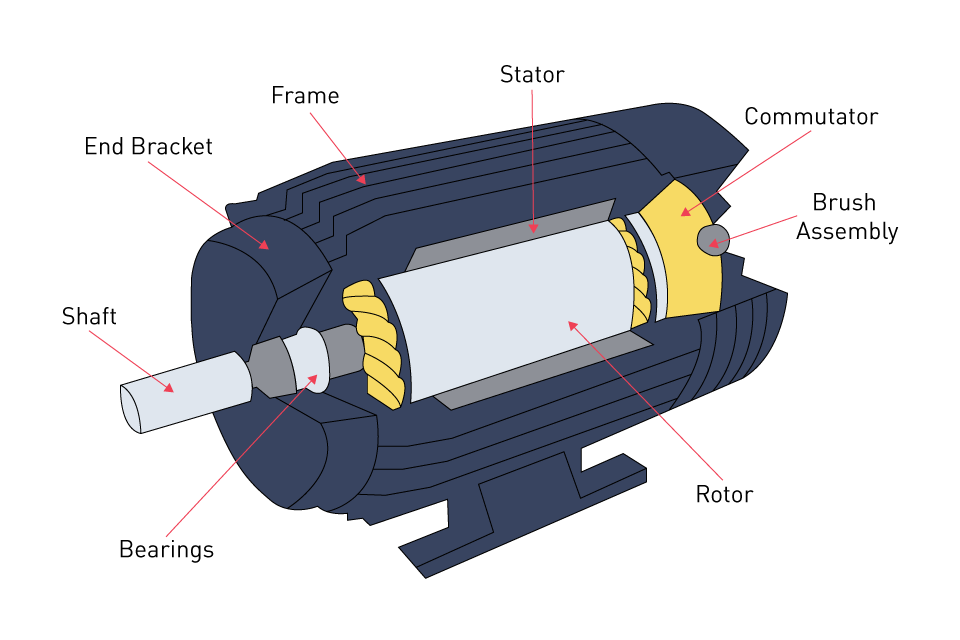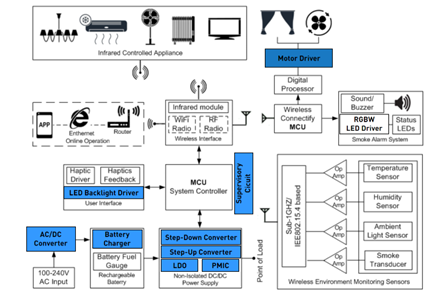History and Evolution of Motors
Brief History of Electric Motors
A time characterized by swift scientific discoveries and innovations, the history of electric motors can be traced back to the early 19th century. In 1821, Michael Faraday laid the groundwork for modern electric motors by demonstrating electromagnetic rotation, which forms the basis of electric motor principles. With a permanent magnet positioned at its center, Faraday's experiment entailed a freely suspended wire submerged in a pool of mercury. As an electric current flowed through the wire, it revolved around the magnet, demonstrating that electromagnetic forces could generate continuous rotary motion.

Figure 1: Faraday Motor
In the following decades, there were gradual enhancements. An essential element in direct current (DC) motors, in 1832, William Sturgeon devised the commutator. Practical and efficient electric motors were not developed until the latter half of the 19th century. The Gramme machine, invented by Belgian innovator Zenobe Gramme in 1873, marked the advent of commercial electric motors as the first motor capable of generating continuous rotary motion.
Key Developments and Innovators in Motor Technology
During the late 19th and early 20th centuries, significant advancements took place in the field of electric motors. A fundamental principle for alternating current (AC) induction motors, the rotating magnetic field, was independently discovered by Nikola Tesla and Galileo Ferraris. Particularly, Tesla played a crucial role in the advancement of the AC motor, for which he obtained a patent in 1888. Transforming the generation, transmission, and utilization of electricity, his efforts laid the foundation for the widespread acceptance of AC power systems.
Resulting in their successful commercial application, especially in electric streetcars, Frank Julian Sprague, another notable contributor, enhanced Thomas Edison's DC motors. Improved brush design and an automatic regulator overseeing speed were among his innovations, along with a more dependable and effective commutator.
Further refinements and diversification in motor technology characterized the 20th century. In the mid-20th century, the advancement of semiconductor electronics allowed for precise control of motor operation, resulting in the emergence of stepper motors and servo motors, both essential components in robotics and automation. Better control over AC motor speed and torque was facilitated by the introduction of variable frequency drives (VFDs).
In recent years, there has been a shift in focus towards enhancing the energy efficiency and environmental friendliness of motors. As a result, brushless DC motors have been developed, and there have been advancements in materials technology, including the utilization of rare-earth magnets to enhance efficiency.
Types of Motors
Overview of Different Motor Types
Each designed for specific applications, electric motors, integral components in modern engineering, exist in various forms. In the realm of electrical engineering, grasping the diversity and functionality of these motors is crucial.
Direct Current (DC) Motors: Renowned for their high starting torque and the ability to control variable speed, direct current (DC) motors are fueled by direct current. They are optimal for applications that necessitate speed control. Brushed and brushless types further categorize DC motors. Brushless DC motors achieve commutation through an external electronic switch, whereas brushed DC motors feature brushes and a commutator.
Alternating Current (AC) Motors: Extensively utilized because of their simplicity, reliability, and cost-effectiveness, AC motors are powered by alternating current. Mainly categorized into two types, they include induction (or asynchronous) motors and synchronous motors. Whereas synchronous motors are employed in situations requiring precise constant speed, induction motors are highly favored for their ruggedness and simplicity, making them popular.
Universal Motors: Universal motors, distinguished by their high speed and compact size, have the capability to operate on either AC or DC power. Commonly encountered in domestic appliances and portable power tools, they are frequently used.
Stepper Motors: Ideal for applications necessitating precise control of position and speed, as observed in 3D printers and CNC machines, stepper motors operate in discrete steps. Typically exhibiting lower overall power output, while offering superb control of rotational angle and speed.
Servo Motors: Encompassing a control circuit, feedback device, and motor, servo motors are integral components of a closed-loop system. Ideal for high-precision positioning in applications such as robotics, antenna positioning, and automated manufacturing systems.
Basic Characteristics and Distinctions
The fundamental difference among these motor types lies in how they operate, their control mechanisms, and their applications.
Speed control is prioritized in applications where DC Motors are preferred. They excel in converting energy to mechanical power, particularly at low speeds, which renders them suitable for variable-speed or battery-powered applications.
Fixed-speed applications commonly utilize AC Motors. The preferred option for industrial and commercial applications is often determined by their durability and minimal maintenance requirements.
Due to increased wear caused by brushes, Universal Motors, despite boasting high power and a compact design, are less suitable for continuous applications.
In applications where position control outweighs torque considerations, Stepper Motors are frequently employed, offering precise control.
To precisely control angular or linear position, velocity, and acceleration, Servo Motors are utilized. They are indispensable components in advanced control systems, although they are typically more intricate and costly.
Components of Electric Motors
Key Components
Each fulfilling a crucial role in their operation, regardless of type, electric motors share several fundamental components. A fundamental aspect of studying motor technology involves understanding these components.
Rotor: In most motors, the rotor comprises either conductive windings or a laminated steel core with embedded magnet wire, serving as the rotating component of the motor. Converting electrical energy into mechanical energy, the movement of the rotor serves as the output of the motor.
Stator: Surrounding the rotor, the stator is the stationary component of the motor. While providing a return path for the magnetic flux, it typically consists of laminated steel and supports the rotor. The stator contains windings through which the input electrical energy is delivered in numerous motor types.
Bearings: Supporting the rotation of the rotor, bearings minimize friction. Bearings guarantee that the rotor spins freely and aligns correctly with the stator, crucial for ensuring the smooth operation and longevity of the motor.
Commutator (in brushed motors): To ensure that current flows in a single direction, this component, exclusive to brushed motors, functions as a switch. Comprising segmented conductive rings connected to the rotor windings, forming this component.

Figure 2: Components of an Electric Motor
Optional Components
Electric motors may also incorporate various optional components that improve their functionality, control, and longevity, in addition to these fundamental parts.
Holding Brakes: Essential in applications where the motor maintains a load in a fixed position, these components are utilized to prevent the motor shaft from rotating when power is not applied.
Cooling Fans: Significant heat is generated by high-power motors. To prevent damage and maintain efficiency, cooling fans aid in dissipating this heat.
Shaft Seals: These seals safeguard the internal components by preventing lubricant leakage from the bearings and blocking contaminants from entering the motor.
Sensors: Various sensors, including those for speed monitoring, position control, and temperature measurement, are incorporated into many modern motors. Particularly in servo and stepper motors, these sensors are essential in feedback control systems.
Function and Significance of Each Component
Every element of an electric motor serves a distinct function:
- Motion is generated through the collaboration of the rotor and stator. A force is induced on the rotor by the electromagnetic field of the stator, resulting in its rotation.
- The conversion of electrical energy occurs within the windings, directly influencing the efficiency and power output of the motor.
- By decreasing friction and wear, bearings enhance the lifespan and reliability of the motor.
- In brushed motors, commutators function to alter the current direction, preserving the rotational orientation of the rotor.
Incorporating optional components such as holding brakes, cooling fans, and sensors enhances the motor's performance in specific applications by adding functionality and control. Control and reliability are paramount in precision and high-power applications, making these components particularly important.




直接登录
创建新帐号